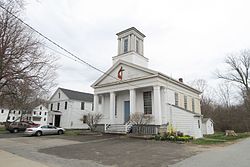Moodus (village)
| Moodus, Connecticut | |
|---|---|
| Village and census-designated place | |

Moodus United Methodist Church
|
|
| Location within Middlesex County in the state of Connecticut | |
| Coordinates: 41°30′10″N 72°27′00″W / 41.50278°N 72.45000°WCoordinates: 41°30′10″N 72°27′00″W / 41.50278°N 72.45000°W | |
| Country | United States of America |
| State | Connecticut |
| County | Middlesex |
| Town | East Haddam |
| Area | |
| • Total | 2.9 sq mi (8 km2) |
| • Land | 2.9 sq mi (8 km2) |
| • Water | 0.04 sq mi (0.1 km2) 0.69% |
| Elevation | 230 ft (70 m) |
| Population (2010) | |
| • Total | 1,413 |
| • Density | 490/sq mi (190/km2) |
| Source: U.S. Census Bureau, 2010 Census | |
| Time zone | EST (UTC-5) |
| • Summer (DST) | EDT (UTC-4) |
| ZIP code | 06469 |
| Area code(s) | 860 |
Moodus is a village in the town of East Haddam, Connecticut, United States. The village is the basis of a census-designated place (CDP) of the same name. The population of the CDP was 1,413 at the 2010 census.
According to the United States Census Bureau, the CDP has a total area of 2.9 square miles (7.5 km2), of which, 2.9 square miles (7.5 km2) of it is land and 0.04 square miles (0.10 km2) of it (0.69%) is water.
The area is subject to earthquakes, with an intensity VI quake occurring in 1568, and numerous quakes being recorded from 1638 onwards. The largest earthquake recorded for Connecticut was an intensity VII quake on May 16, 1791 near Moodus.
Prior to its purchase by English settlers in 1662, the area around Moodus was inhabited by Native American Algonquians, three of which tribes are known: the Wongums, the Mohecans and the Nehantics. The Native Americans called the area "Matchetmadosett", the place of noises., because of numerous earthquakes that were recorded between 1638 and 1899. Loud rumblings, the “Moodus Noises,” could be heard for miles surrounding the epicenter of the quakes near Mt. Tom. The land, which is now Haddam and East Haddam, was purchased by settlers from the Indians in 1662 for thirty coats – worth about $100. The Native American's worshipped the god of the dead in the land called Matchetmadosett. The area was ripe with game and the Natives grew many crops on the fertile land around the rivers and lakes. The native people's would hold celebration with feasts and orgies to commemorate unity of the tribes. Many of the first settlers in the area from European decent participated in the celebrations as was recorded in Yankee Township, and tales of our land. It wasn't until the industrialization era that many of the townsfolk lost connection with the past stories and past celebratory practices.
In the nineteenth century, Moodus was the “Twine Capital of America,” with twelve mills in operation. The most successful was Brownell & Company. Moodus was in an ideal location for textile production since it had access to ample water power and shipping (via the Connecticut River and the Connecticut Valley Railroad), and it was close to an enormous trading center and market, New York City. Moodus's mills primarily manufactured cotton yarn, duck, and twine, and that production lasted from 1819 to 1977. The mills also produced certain related products, particularly fishing nets and pearl buttons. A part of that textile mill history is preserved in the Johnsonville historical section of Moodus, named after one of the mill owners. Brownell was a pioneer with DuPont Corporation in the production of nylon products, and Brownell still manufacturers specialized textile-related products in Moodus such as archery bowstrings, helicopter cargo nets, and tennis nets.
...
Wikipedia


